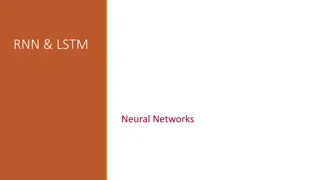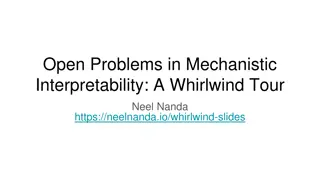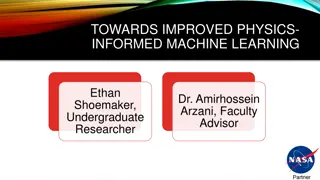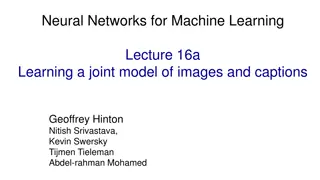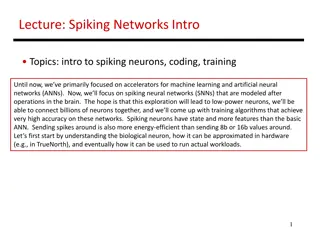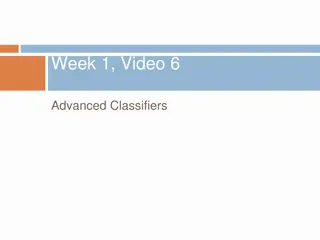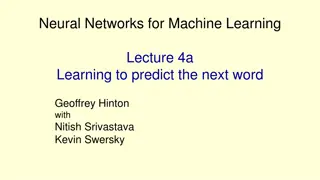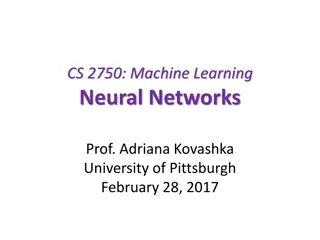Evolution of Neural Networks through Neuroevolution by Ken Stanley
Ken Stanley, a prominent figure in neuroevolution, has made significant contributions to the field, such as co-inventing NEAT and HyperNEAT. Through neuroevolution, complex artifacts like neural networks evolve, with the most complex known to have 100 trillion connections. The combination of evolutionary computation and neural networks offers a natural path to AI, dating back to the 1980s. Neuroevolution differs from deep learning by not using stochastic gradient descent and focuses on creating individuals rather than individual learning. The goal is to understand how complexity evolved and create open-ended systems that foster creativity.
Download Presentation

Please find below an Image/Link to download the presentation.
The content on the website is provided AS IS for your information and personal use only. It may not be sold, licensed, or shared on other websites without obtaining consent from the author.If you encounter any issues during the download, it is possible that the publisher has removed the file from their server.
You are allowed to download the files provided on this website for personal or commercial use, subject to the condition that they are used lawfully. All files are the property of their respective owners.
The content on the website is provided AS IS for your information and personal use only. It may not be sold, licensed, or shared on other websites without obtaining consent from the author.
E N D
Presentation Transcript
Evolving Neural Networks through Neuroevolution Kenneth O. Stanley Uber AI Labs And Evolutionary Complexity Research Group, Department of Computer Science, University of Central Florida kstanley@uber.com kstanley@cs.ucf.edu
Presenter Ken Stanley s connections to neuroevolution (NE): Co-inventor of NEAT (with Risto Miikkulainen) Inventor of CPPNs Co-inventor of HyperNEAT (with David D Ambrosio and Jason Gauci) Co-inventor of novelty search (with Joel Lehman) Coauthor of Why Greatness Cannot Be Planned (with Joel Lehman)
Quiz What is the most complex artifact in the known universe?
Quiz What is the most complex artifact in the known universe?
Quiz What is the most complex artifact in the known universe? 100 trillion connections
Quiz What is the most complex artifact in the known universe? 100 trillion connections How did it get here?
Quiz What is the most complex artifact in the known universe? 100 trillion connections How did it get here? Evolution
Main Idea: Combine Evolutionary Computation and Neural Networks Space-filling model of a section of DNA molecule Evolving brains : Neural networks compete and evolve Idea dates back to the 1980s Natural path to AI: Only way that intelligence ever really was created
Difference from Deep Learning? No stochastic gradient descent Not used in NE Ubiquitous in deep learning Deep learning: how an individual learns NE: how to create an individual (who may be able to learn) Possible synergies: Neuroevolved networks could learn during lifetime through DL
Why Neuroevolution? We don t understand how complexity evolved many deep lessons Evolution is a sandbox for creativity We want to create open-ended systems Not everything is differentiable E.g. architecture, hyperparameters Exact gradient is not always the best move As computation increases, gradient estimation becomes more tractable Easy formulations with sparse rewards
Neural Networks Make Decisions Forward Left Right Front Left Right Back If we knew the right actions we could target them But often feedback is sparse (as in reinforcement learning) Evolution is naturally suited to sparse feedback (e.g. life) Because of natural independence from direct supervision, neuroevolution tends towards very diverse applications
Diverse Applications Rocket Control 22 Evolving Pictures 52,53 Video Game NPC Control 59 Evolving Music 28,29 Real-world Robot Control 34 Video Game Content Generation 27
What Is an Evolutionary Algorithm? Inspired by evolution in nature But not exactly the same 1. Generate random configurations 2. Choose the better as parents (Actually a very complicated issue) 3. Next generation is (hopefully) a bit better 4. And so on Basically: automated breeding Or, a diverse set of parallel gradient estimators
The Neuroevolution Problem What is the topology that works? What are the weights that work? ? ? ? ? ? ? ? ? ? ? ? ? ?
Earliest NE Methods Only evolved Weights Genome is a direct encoding Genes represent a vector of weights Could be a bit string or real valued NE optimizes the weights for the task Maybe a replacement for backprop/SGD ? ? ? ? ? ? ? ? ? ? ? ? ? ? ? ? ? ? ? ?
TWEANNS Topology and Weight Evolving Artificial Neural Networks 3,14,17,61,75 Population contains diverse topologies Why leave anything to humans? Topology evolution can combine w/ backprop
Competing Conventions with Arbitrary Topologies Topology matching problem No clear solution to mating arbitrary topologies How do they match up? Radcliffe (1993) : Holy Grail in this area. 48
The Loss of Innovation Problem Innovative structures have more connections Innovative structure cannot compete with simpler ones Yet the money is on innovation in the long run Need some kind of protection for innovation
NeuroEvolution of Augmenting Topologies (NEAT) 61,63 NEAT addressed the major TWEANN problems: Topology matching problem Loss of innovative structures Initial population topology randomization
Historical Marking in NEAT Addresses topology-matching problem
Protecting Innovation in NEAT Addresses loss of innovative structures Achieved through speciation Individuals compete primarily with others of similar topology
Complexification from Minimal Structure in NEAT Addresses initialization problem Search begins in minimal-topology space Lower-dimensional structures easily optimized Useful innovations eventually survive So search transitions into good part of higher-dim. space The ticket to high-dimensional space
Advantages of NEAT Unbounded complexity Potential for near-minimal solutions Diverse topologies and solutions in one run Double Pole Balancing Record 61 Vehicle Warnings 34 NewHopper3 Keepaway Record 66 lazy-img NERO: Real-time Neuroevolution in a Video Game 59 Robot Duel 63 Go 64 Hopper 13
NEAT: Beyond Control and Classification Interactive Picture Evolution 52 Harmonic Accompaniment Evolution 29 Interactive Drum Pattern Evolution 28 Guitar Effect-Pedal Emulation Interactive Particle Effect Evolution 26
After NEAT: Shift Towards Indirect Encoding Also called Generative and Developmental Systems3,14,24,39,55,62,75 Space-filling model of a section of DNA molecule 100 trillion connections in the human brain 30,000 genes in the human genome Only possible through highly compressed representation (indirect encoding)
An Interesting Observation NEAT-evolved networks (called CPPNs) produce nice patterns: Can this ability help to evolve brains?
HyperNEAT: A CPPN Can Paint the Network s Connectivity Massive networks can be painted with regular patterns of weights Stanley, Kenneth O., David B. D'Ambrosio, and Jason Gauci. "A hypercube-based encoding for evolving large-scale neural networks." Artificial life 15.2 (2009): 185-212.
Example HyperNEAT Substrates Quadruped Gaits 6,7 Checkers 18,19 Robocup 70
Thena Surprising Discovery Experiments in interactive evolution of images reveal something shocking: The only way to find something interesting is not to be looking for it Leads to the novelty search algorithm Search only for behavioral novelty, not an objective Lehman, Joel, and Kenneth O. Stanley. "Abandoning objectives: Evolution through the search for novelty alone." Evolutionary computation 19.2 (2011): 189-223.
Counterintuitive NS Results Novelty search found better solutions than objective-driven search in many domains Biped locomotion: Better walkers evolve Led to a new field called quality diversity algorithms
Significant NE Applications Event selection for most accurate measurement of the top quark at the Tevatron particle accelerator optimized by NEAT Observation of Electroweak Single Top-Quark Production T. Aaltonen et al. (CDF Collaboration) Phys. Rev. Lett. 103, 092002 Published 24 August 2009
Significant NE Applications Robots recovering from damage through MAP-Elites on the cover of Nature Cully, A., Clune, J., Tarapore, D., and Mouret, J.-B. "Robots that can adapt like animals." Nature, 521.7553 (2015)
Significant NE Applications Picbreeder! Secretan, Jimmy, et al. "Picbreeder: A case study in collaborative evolutionary exploration of design space." Evolutionary Computation 19.3 (2011): 373-403.
Significant NE Applications Galactic Arms Race game: invents its own weapons as the game is played (over 2000 copies sold) Ultra-Wide CorkScrew Ladder Tunnel Maker Wall Gun Trident
Significant NE Applications CPPNs in Physical Design Richards, D., and M. Amos. "Designing with gradients: bio-inspired computation for digital fabrication." Proceedings of ACADIA. 2014. AdamGaier. Evolutionary Design via Indirect Encoding of Non-Uniform Rational Basis Splines. Proceedings of the Companion Publication of the 2015 Annual Conference on Genetic and Evolutionary Computation. 2015. Storsveen, Anders. "Evolving a 2D Model of an Eye using CPPNs. NTNU Masters Thesis, 2008. Evins, Ralph, Ravi Vaidyanathan, and Stuart Burgess. "Multi- material compositional pattern-producing networks for form optimisation." Applications of Evolutionary Computation. Springer Berlin Heidelberg, 2014. 189-200. Nicholas Cheney, Ethan Ritz, and Hod Lipson. 2014. Automated vibrational design and natural frequency tuning of multi-material structures. In Proceedings of the 2014 Annual Conference on Genetic and Evolutionary Computation (GECCO '14). ACM, New York, NY, USA, 1079-1086.
Significant NE Applications Insights into society and life
Recent Surprise: Evolution Strategies in RL From OpenAI: Variant of neuroevoltion based on ES competitive with Deep RL methods in Atari and MuJoCo domains From https://blog.openai.com/evolution-strategies/ Significance: Evolution can competitively optimize very high-dimensional networks directly (order of 1 million dimensions) Salimans, T., Ho, J., Chen, X., & Sutskever, I. (2017). Evolution strategies as a scalable alternative to reinforcement learning. arXiv preprint arXiv:1703.03864.
Advanced Issues NE for architecture search for DL Recently popular Evolution of plasticity
Major Research Questions Is high dimensionality in NE caving to computation? (as in DL) Is NE a promising partner to DL? Improvements in quality diversity What is the killer app for quality diversity? Grand challenge: Open-ended evolution Increasing complexity and novelty forever Path to AI?
Getting Started NEAT / HyperNEAT / Novelty Search software catalog: http://eplex.cs.ucf.edu/neat_software/ ES blog post: https://blog.openai.com/evolution-strategies/ My UCF homepage: http://www.cs.ucf.edu/~kstanley/ Uber AI Labs: http://uber.ai/ kstanley@uber.com or kstanley@cs.ucf.edu Also: Meet the Expert Table 1 @1:45pm
Classic References [1] Aaltonen et al. (over 100 authors) (2009). Measurement of the top quark mass with dilepton events selected using neuroevolution at CDF. Physical Review Letters, 102(15):2001. [2] Agogino, A., Tumer, K., and Miikkulainen, R. (2005). Efficient credit assignment through evaluation function decomposition. In Proceedings of the Genetic and Evolutionary Computation Conference. [3] Angeline, P. J., Saunders, G. M., and Pollack, J. B. (1993). An evolutionary algorithm that constructs recurrent neural networks. IEEE Transactions on Neural Networks, 5:54 65. [4] Angeline, P. J., Saunders, G. M., and Pollack, J. B. (2000). An evolutionary algorithm that constructs recurrent neural networks. IEEE Transactions on Neural Networks. [5] Cliff, D., Harvey, I., and Husbands, P. (1993). Explorations in evolutionary robotics. Adaptive Behavior, 2:73 110. [6] Clune, J., Pennock, R. T., and Ofria, C. (2009). The sensitivity of HyperNEAT to different geomet- ric representations of a problem. In Proceedings of the Genetic and Evolutionary Computation Conference (GECCO-2009). New York, NY, USA: ACM Press. [7] Clune, J., Stanley, K. O., Pennock, R. T., and Ofria, C. (2011). On the performance of indirect encoding across the continuum of regularity. IEEE Transactions on Evolutionary Computation. [8] D Ambrosio, D., Lehman, J., Risi, S., and Stanley, K. O. (2010). Evolving policy geometry for scal- able multiagent learning. In Proceedings of the Ninth International Conference on Autonomous Agents and Multiagent Systems (AAMAS-2010), 731 738. International Foundation for Autonomous Agents and Multiagent System. [9] D Ambrosio, D., Lehman, J., Risi, S., and Stanley, K. O. (2011). Task switching in multiagent learning through indirect encoding. In Proceedings of the International Conference on Intelligent Robots and Systems (IROS 2011). Piscataway, NJ: IEEE. [10] D Ambrosio, D. B., and Stanley, K. O. (2008). Generative encoding for multiagent learning. In Pro- ceedings of the Genetic and Evolutionary Computation Conference (GECCO 2008). New York, NY: ACM Press.
[11] Desai, N. S., and Miikkulainen, R. (2000). Neuro-evolution and natural deduction. In Proceedings of The First IEEE Symposium on Combinations of Evolutionary Computation and Neural Networks, 64 69. Piscataway, NJ: IEEE. [12] Dubbin, G., and Stanley, K. O. (2010). Learning to dance through interactive evolution. In Proceed- ings of the Eigth European Event on Evolutionary and Biologically Inspired Music, Sound, Art and Design (EvoMUSART 2010). New York, NY: Springer. [13] Fagerlund, M. (2003 2006). DelphiNEAT homepage. http://www.cambrianlabs.com/mattias/DelphiNEAT/. [14] Floreano, D., Du rr, P., and Mattiussi, C. (2008). Neuroevolution: from architectures to learning. Evolu- tionary Intelligence, 1:47 62. [15] Floreano, D., and Mondada, F. (1998). Evolutionary neurocontrollers for autonomous mobile robots. Neural Networks, 11:1461 1478. [16] Floreano, D., and Urzelai, J. (2000). Evolutionary robots with on-line self-organization and behavioral fitness. Neural Networks, 13:431 4434. [17] Fullmer, B., and Miikkulainen, R. (1992). Using marker-based genetic encoding of neural networks to evolve finite-state behaviour. In Varela, F. J., and Bourgine, P., editors, Toward a Practice of Autonomous Systems: Proceedings of the First European Conference on Artificial Life, 255 262. Cambridge, MA: MIT Press. [18] Gauci, J., and Stanley, K. O. (2008). A case study on the critical role of geometric regularity in machine learning. In Proceedings of the Twenty-Third AAAI Conference on Artificial Intelligence (AAAI-2008). Menlo Park, CA: AAAI Press. [19] Gauci, J., and Stanley, K. O. (2010). Autonomous evolution of topographic regularities in artificial neural networks. Neural Computation, 22(7):1860 1898. [20] Gomez, F. (2003). Robust Non-Linear Control Through Neuroevolution. PhD thesis, Department of Com- puter Sciences, The University of Texas at Austin. [21] Gomez, F., Burger, D., and Miikkulainen, R. (2001). A neuroevolution method for dynamic resource allocation on a chip multiprocessor. In Proceedings of the INNS-IEEE International Joint Conference on Neural Networks, 2355 2361. Piscataway, NJ: IEEE. [22] Gomez, F., and Miikkulainen, R. (2003). Active guidance for a finless rocket using neuroevolution. In Proceedings of the Genetic and Evolutionary Computation Conference, 2084 2095. San Francisco: Kaufmann.
[23] Greer, B., Hakonen, H., Lahdelma, R., and Miikkulainen, R. (2002). Numerical optimization with neuroevolution. In Proceedings of the 2002 Congress on Evolutionary Computation, 361 401. Piscataway, NJ: IEEE. [24] Gruau, F., and Whitley, D. (1993). Adding learning to the cellular development of neural networks: Evolution and the Baldwin effect. Evolutionary Computation, 1:213 233. [25] Gruau, F., Whitley, D., and Pyeatt, L. (1996). A comparison between cellular encoding and direct encoding for genetic neural networks. In Koza, J. R., Goldberg, D. E., Fogel, D. B., and Riolo, R. L., editors, Genetic Programming 1996: Proceedings of the First Annual Conference, 81 89. Cambridge, MA: MIT Press. [26] Hastings, E., Guha, R., and Stanley, K. O. (2007). Neat particles: Design, representation, and animation of particle system effects. In Proceedings of the IEEE Symposium on Computational Intelligence and Games (CIG-07). Piscataway, NJ: IEEE Press. [27] Hastings, E. J., Guha, R. K., and Stanley, K. O. (2010). Automatic content generation in the galactic arms race video game. IEEE Transactions on Computational Intelligence and AI in Games, 1(4):245 263. [28] Hoover, A. K., and Stanley, K. O. (2009). Exploiting functional relationships in musical composition. Connection Science Special Issue on Music, Brain, and Cognition, 21(2 and 3):227 251. [29] Hoover, A. K., Szerlip, P. A., and Stanley, K. O. (2011). Interactively evolving harmonies through functional scaffolding. In GECCO 11: Proceedings of the 13th annual conference on Genetic and evolutionary computation, 387 394. Dublin, Ireland: ACM. [30] Hornby, G. S., and Pollack, J. B. (2002). Creating high-level components with a generative representa- tion for body-brain evolution. Artificial Life, 8(3). [31] Hornby, G. S., Takamura, S., Yokono, J., Hanagata, O., Fujita, M., and Pollack, J. (2000). Evolution of controllers from a high- level simulator to a high DOF robot. In Evolvable Systems: From Biology to Hardware; Proceedings of the Third International Conference, 80 89. Berlin: Springer. [32] Igel, C. (2003). Neuroevolution for reinforcement learning using evolution strategies. In Sarker, R., Reynolds, R., Abbass, H., Tan, K. C., McKay, B., Essam, D., and Gedeon, T., editors, Proceedings of the 2003 Congress on Evolutionary Computation, 2588 2595. Piscataway, NJ: IEEE Press. [33] James, D., and Tucker, P. (2005). Evolving a neural network active vision system for shape discrimina- tion. In Proceedings of the Genetic and Evolutionary Computation Conference (GECCO 2005) Late Breaking Papers. New York, NY: ACM Press.
[34] Kohl, N., Stanley, K., Miikkulainen, R., Samples, M., and Sherony, R. (2006). Evolving a real-world vehicle warning system. In Proceedings of the Genetic and Evolutionary Computation Conference (GECCO 2006), 1681 1688. [35] Lehman, J., and Stanley, K. O. (2008). Exploiting open-endedness to solve problems through the search for novelty. In Bullock, S., Noble, J., Watson, R., and Bedau, M., editors, Proceedings of the Eleventh International Conference on Artificial Life (Alife XI). Cambridge, MA: MIT Press. [36] Lehman, J., and Stanley, K. O. (2011). Abandoning objectives: Evolution through the search for novelty alone. Evolutionary Computation, 19(2):189 223. [37] Mattiussi, C., and Floreano, D. (2006). Analog Genetic Encoding for the Evolution of Circuits and Networks. IEEE Transactions on Evolutionary Computation, 11(5):596 607. [38] McDonnell, J. R., and Waagen, D. (1994). Evolving recurrent perceptrons for time-series modeling. IEEE Transactions on Evolutionary Computation, 5:24 38. [39] Mjolsness, E., Sharp, D. H., and Alpert, B. K. (1989). Scaling, machine learning, and genetic neural nets. Advances in Applied Mathematics, 10:137 163. [40] Montana, D. J., and Davis, L. (1989). Training feedforward neural networks using genetic algorithms. In Proceedings of the 11th International Joint Conference on Artificial Intelligence, 762 767. San Francisco: Kaufmann. [41] Moriarty, D. E. (1997). Symbiotic Evolution of Neural Networks in Sequential Decision Tasks. PhD thesis, Department of Computer Sciences, The University of Texas at Austin. Technical Report UT-AI97-257. [42] Moriarty, D. E., and Miikkulainen, R. (1996). Evolving obstacle avoidance behavior in a robot arm. In Maes, P., Mataric, M. J., Meyer, J.-A., Pollack, J., and Wilson, S. W., editors, From Animals to Animats 4: Proceedings of the Fourth International Conference on Simulation of Adaptive Behavior, 468 475. Cambridge, MA: MIT Press. [43] Moriarty, D. E., and Miikkulainen, R. (1997). Forming neural networks through efficient and adaptive co-evolution. Evolutionary Computation, 5:373 399. [44] Mouret, J.-B., and Doncieux, S. (2009). Overcoming the bootstrap problem in evolutionary robotics using behavioral diversity. In Proceedings of the IEEE Congress on Evolutionary Computation (CEC-2009, 1161 1168. IEEE.
[45] Nolfi, S., and Floreano, D. (2000). Evolutionary Robotics. Cambridge: MIT Press. [46] Potter, M. A., and Jong, K. A. D. (2000). Cooperative coevolution: An architecture for evolving coad- apted subcomponents. Evolutionary Computation, 8:1 29. [47] Pujol, J. C. F., and Poli, R. (1998). Evolving the topology and the weights of neural networks using a dual representation. Applied Intelligence Journal, 8(1):73 84. Special Issue on Evolutionary Learning. [48] Radcliffe, N. J. (1993). Genetic set recombination and its application to neural network topology opti- mization. Neural computing and applications, 1(1):67 90. [49] Risi, S., and Stanley, K. O. (2010). Indirectly encoding neural plasticity as a pattern of local rules. In Proceedings of the 11th International Conference on Simulation of Adaptive Behavior (SAB2010). Berlin: Springer. [50] Risi, S., and Stanley, K. O. (2011). Enhancing ES-HyperNEAT to evolve more complex regular neural networks. In GECCO 11: Proceedings of the 13th annual conference on Genetic and evolutionary computation, 1539 1546. Dublin, Ireland: ACM. [51] Schaffer, J. D., Whitley, D., and Eshelman, L. J. (1992). Combinations of genetic algorithms and neural networks: A survey of the state of the art. In Whitley, D., and Schaffer, J., editors, Proceedings of the International Workshop on Combinations of Genetic Algorithms and Neural Networks, 1 37. Los Alamitos, CA: IEEE Computer Society Press. [52] Secretan, J., Beato, N., D.Ambrosio, D. B., Rodriguez, A., Campbell, A., Folsom-Kovarik, J. T., and Stanley, K. O. (2011). Picbreeder: A case study in collaborative evolutionary exploration of design space. Evolutionary Computation, 19(3):345 371. [53] Secretan, J., Beato, N., D Ambrosio, D. B., Rodriguez, A., Campbell, A., and Stanley, K. O. (2008). Picbreeder: Evolving pictures collaboratively online. In CHI 08: Proceedings of the twenty-sixth annual SIGCHI conference on Human factors in computing systems, 1759 1768. New York, NY, USA: ACM. [54] Seys, C. W., and Beer, R. D. (2004). Evolving walking: The anatomy of an evolutionary search. In Schaal, S., Ijspeert, A., Billard, A., Vijayakumar, S., Hallam, J., and Meyer, J.-A., editors, From Animals to Animats 8: Proceedings of the Eight International Conference on Simulation of Adaptive Behavior, 357 363. Cambridge, MA: MIT Press. [55] Siddiqi, A. A., and Lucas, S. M. (1998). A comparison of matrix rewriting versus direct encoding for evolving neural networks. In Proceedings of IEEE International Conference on Evolutionary Computation, 392 397. Piscataway, NJ: IEEE.
[56] Sit, Y. F., and Miikkulainen, R. (2005). Learning basic navigation for personal satellite assistant using neuroevolution. In Proceedings of the Genetic and Evolutionary Computation Conference. [57] Stanley, K. O. (2003). Efficient Evolution of Neural Networks Through Complexification. PhD thesis, De- partment of Computer Sciences, The University of Texas at Austin, Austin, TX. [58] Stanley, K. O. (2007). Compositional pattern producing networks: A novel abstraction of development. Genetic Programming and Evolvable Machines Special Issue on Developmental Systems, 8(2):131 162. [59] Stanley, K. O., Bryant, B. D., and Miikkulainen, R. (2005). Real-time neuroevolution in the NERO video game. IEEE Transactions on Evolutionary Computation Special Issue on Evolutionary Computation and Games, 9(6):653 668. [60] Stanley, K. O., D Ambrosio, D. B., and Gauci, J. (2009). A hypercube-based indirect encoding for evolving large-scale neural networks. Artificial Life, 15(2):185 212. [61] Stanley, K. O., and Miikkulainen, R. (2002). Evolving neural networks through augmenting topologies. Evolutionary Computation, 10:99 127. [62] Stanley, K. O., and Miikkulainen, R. (2003). A taxonomy for artificial embryogeny. Artificial Life, 9(2):93 130. [63] Stanley, K. O., and Miikkulainen, R. (2004). Competitive coevolution through evolutionary complexi- fication. Journal of Artificial Intelligence Research, 21:63 100. [64] Stanley, K. O., and Miikkulainen, R. (2004). Evolving a roving eye for Go. In Proceedings of the Genetic and Evolutionary Computation Conference (GECCO-2004). Berlin: Springer Verlag. [65] Sutton, R. S., and Barto, A. G. (1998). Reinforcement Learning: An Introduction. Cambridge, MA: MIT Press. [66] Taylor, M. E., Whiteson, S., and Stone, P. (2006). Comparing evolutionary and temporal difference methods in a reinforcement learning domain. In GECCO 2006: Proceedings of the Genetic and Evolution- ary Computation Conference, 1321 1328.
[67] v. E. Conradie, A., Miikkulainen, R., and Aldrich, C. (2002). Adaptive control utilising neural swarm- ing. In Proceedings of the Genetic and Evolutionary Computation Conference. San Francisco: Kaufmann. [68] v. E. Conradie, A., Miikkulainen, R., and Aldrich, C. (2002). Intelligent process control utilizing sym- biotic memetic neuro- evolution. In Proceedings of the 2002 Congress on Evolutionary Computation. [69] Valsalam, V. K., and Miikkulainen, R. (2008). Modular neuroevolution for multilegged locomotion. In Proceedings of the Genetic and Evolutionary Computation Conference (GECCO 2008). New York, NY: ACM Press. [70] Verbancsics, P., and Stanley, K. O. (2010). Evolving static representations for task transfer. Journal of Machine Learning Research (JMLR), 11:1737 1769. [71] Verbancsics, P., and Stanley, K. O. (2011). Constraining connectivity to encourage modularity in Hyper- NEAT. In GECCO 11: Proceedings of the 13th annual conference on Genetic and evolutionary computation, 1483 1490. Dublin, Ireland: ACM. [72] Whitley, D., Dominic, S., Das, R., and Anderson, C. W. (1993). Genetic reinforcement learning for neurocontrol problems. Machine Learning, 13:259 284. [73] Wieland, A. P. (1990). Evolving controls for unstable systems. In Touretzky, D. S., Elman, J. L., Se- jnowski, T. J., and Hinton, G. E., editors, Connectionist Models: Proceedings of the 1990 Summer School, 91 102. San Francisco: Kaufmann. [74] Woolley, B. G., and Stanley, K. O. (2011). On the deleterious effects of a priori objectives on evolution and representation. In GECCO 11: Proceedings of the 13th annual conference on Genetic and evolutionary computation, 957 964. Dublin, Ireland: ACM. [75] Yao, X. (1999). Evolving artificial neural networks. Proceedings of the IEEE, 87(9):1423 1447. [76] Zhang, B.-T., and Muhlenbein, H. (1993). Evolving optimal neural networks using genetic algorithms with Occam s razor. Complex Systems, 7:199 220.




